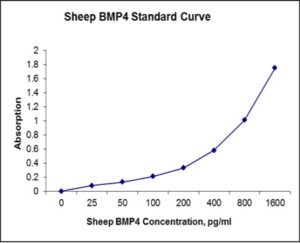Nori Sheep BMP4 ELISA Kit
$508.00 – $916.00
This ELISA kit is for quantification of BMP4 in sheep. This is a quick ELISA assay that reduces time to 50% compared to the conventional method, and the entire assay only takes 3 hours. This assay employs the quantitative sandwich enzyme immunoassay technique and uses biotin-streptavidin chemistry to improve the performance of the assays. An antibody specific for BMP4 has been pre-coated onto a microplate. Standards and samples are pipetted into the wells and any BMP4 present is bound by the immobilized antibody. After washing away any unbound substances, a detection antibody specific for BMP4 is added to the wells. Following wash to remove any unbound antibody reagent, a detection reagent is added. After intensive wash a substrate solution is added to the wells and color develops in proportion to the amount of BMP4 bound in the initial step. The color development is stopped, and the intensity of the color is measured.
Alternative names for BMP4: Bone morphogenetic protein 4, BMP-4
This product is for Laboratory Research Use Only not for diagnostic and therapeutic purposes or any other purposes.
- Description
- How Elisa Works
- Product Citation (0)
- Reviews (0)
Description
Nori Sheep BMP4 ELISA Kit Summary
Alternative names for BMP4: Bone morphogenetic protein 4, BMP-4
Alternative name for sheep: ovine, lamb, goat
| Assay Type | Solid Phase Sandwich ELISA |
| Format | 96-well Microplate or 96-Well Strip Microplate |
| Method of Detection | Colorimetric |
| Number of Targets Detected | 1 |
| Target Antigen Accession Number | A8VTF8 |
| Assay Length | 3 hours |
| Quantitative/Semiquantitative | Quantitative |
| Sample Type | Plasma, Serum, Cell Culture, Urine, Cell/Tissue Lysates, Synovial Fluid, BAL, |
| Recommended Sample Dilution (Plasma/Serum) | No dilution for sample <ULOQ; sufficient dilution for samples >ULOQ |
| Sensitivity | 5 pg/mL |
| Detection Range | 25-1600 pg/mL |
| Specificity | Sheep BMP4 |
| Cross-Reactivity | < 0.5% cross-reactivity observed with available related molecules, < 50% cross-species reactivity observed with species tested. |
| Interference | No significant interference observed with available related molecules |
| Storage/Stability | 4 ºC for up to 6 months |
| Usage | For Laboratory Research Use Only. Not for diagnostic or therapeutic use. |
| Additional Notes | The kit allows for use in multiple experiments. |
Standard Curve
Kit Components
1. Pre-coated 96-well Microplate
2. Biotinylated Detection Antibody
3. Streptavidin-HRP Conjugate
4. Lyophilized Standards
5. TMB One-Step Substrate
6. Stop Solution
7. 20 x PBS
8. Assay Buffer
Other Materials Required but not Provided:
1. Microplate Reader capable of measuring absorption at 450 nm
2. Log-log graph paper or computer and software for ELISA data analysis
3. Precision pipettes (1-1000 µl)
4. Multi-channel pipettes (300 µl)
5. Distilled or deionized water
Protocol Outline
1. Prepare all reagents, samples and standards as instructed in the datasheet.
2. Add 100 µl of Standard or samples to each well and incubate 1 h at RT.
3. Add 100 µl of Working Detection Antibody to each well and incubate 1 h at RT.
4. Add 100 µl of Working Streptavidin-HRP to each well and incubate 20 min at RT.
5. Add 100 µl of Substrate to each well and incubate 5-30 min at RT.
6. Add 50 µl of Stop Solution to each well and read at 450 nm immediately.
Background:
Bone morphogenetic protein 4 (BMP4) is a member of the bone morphogenetic protein family which is part of the transforming growth factor-beta superfamily. This particular family member plays an important role in the onset of endochondral bone formation in humans. It has been shown to be involved in muscle development, bone mineralization, and uteric bud development. In human embryonic development, BMP4 is a critical signaling molecule required for the early differentiation of the embryo and establishing of a dorsal-ventral axis. BMP4 is secreted from the dorsal portion of the notochord, and it acts in concert with sonic hedgehog (released from the ventral portion of the notochord) to establish a dorsal-ventral axis for the differentiation of later structures.BMP4 stimulates differentiation of overlying ectodermal tissue.BMP4 has also been implicated in Fibrodysplasia Ossificans Progressiva in which it is overexpressed (1). Increase in expression of BMP4 has been associated with a variety of bone diseases, including the heritable disorder Fibrodysplasia Ossificans Progressiva.
References
- Kan L, et al. (2004). Am. J. Pathol. 165 (4): 1107
Be the first to review “Nori Sheep BMP4 ELISA Kit”
You must be logged in to post a review.





























Reviews
There are no reviews yet.